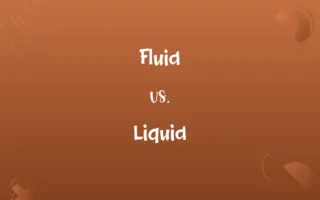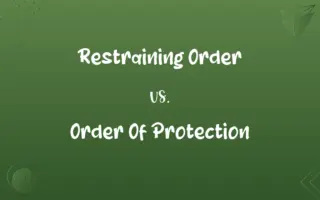Proteasome vs. Protease: Know the Difference

By Shumaila Saeed || Updated on December 25, 2023
Proteasomes are complex protein assemblies that degrade unneeded or damaged proteins in cells, while proteases are enzymes that break down proteins.

Key Differences
Proteasomes are large protein complexes with multiple subunits, forming a barrel-like structure. Proteases are typically smaller, single proteins or enzymes.
Shumaila Saeed
Dec 19, 2023
Proteasomes selectively degrade proteins tagged for destruction in cells, playing a key role in cellular regulation. Proteases non-selectively cleave peptide bonds in proteins.
Shumaila Saeed
Dec 19, 2023
Proteasomes are found in the cytoplasm and nucleus of eukaryotic cells. Proteases are found throughout the body, in various cell types and extracellular spaces.
Shumaila Saeed
Dec 19, 2023
Malfunctions in proteasomes can lead to diseases like cancer. Dysregulated proteases are implicated in disorders like arthritis and Alzheimer's disease.
Shumaila Saeed
Dec 19, 2023
Inhibition of proteasomes is a strategy in cancer therapy, as seen with drugs like Bortezomib. Protease inhibitors are used in treating conditions like HIV.
Shumaila Saeed
Dec 19, 2023
ADVERTISEMENT
Comparison Chart
Definition
A protein complex for degrading proteins
An enzyme that breaks down proteins
Shumaila Saeed
Dec 19, 2023
Function Specificity
Highly selective in degrading proteins
Non-selective in protein cleavage
Shumaila Saeed
Dec 19, 2023
Location in Cells
Mainly in cytoplasm and nucleus
Widespread, including extracellular areas
Shumaila Saeed
Dec 19, 2023
Role in Diseases
Linked to cancer when dysfunctional
Implicated in various disorders
Shumaila Saeed
Dec 19, 2023
ADVERTISEMENT
Proteasome and Protease Definitions
Proteasome
A cellular complex that degrades unneeded or damaged proteins.
The proteasome plays a crucial role in maintaining cellular homeostasis.
Shumaila Saeed
Dec 11, 2023
Protease
An enzyme that catalyzes the breakdown of proteins.
Proteases are vital for protein digestion in the human body.
Shumaila Saeed
Dec 11, 2023
Proteasome
An integral part of the ubiquitin-proteasome pathway.
Proteasomes are responsible for degrading proteins tagged by ubiquitin.
Shumaila Saeed
Dec 11, 2023
Protease
A biological molecule that cleaves peptide bonds.
Proteases play a key role in cellular protein turnover.
Shumaila Saeed
Dec 11, 2023
Proteasome
A key player in the controlled degradation of intracellular proteins.
Without proteasomes, cells cannot efficiently recycle amino acids.
Shumaila Saeed
Dec 11, 2023
ADVERTISEMENT
Protease
An enzyme that hydrolyzes protein substrates.
The action of proteases is essential in many biological processes.
Shumaila Saeed
Dec 11, 2023
Proteasome
A multi-enzyme protein complex in eukaryotic cells.
Proteasomes are essential for regulating protein concentration in cells.
Shumaila Saeed
Dec 11, 2023
Protease
A catalyst in the proteolytic cleavage of protein molecules.
Proteases are involved in the activation of zymogens in the digestive system.
Shumaila Saeed
Dec 11, 2023
Proteasome
A structure involved in degrading misfolded proteins.
Proteasomes help prevent diseases caused by protein aggregation.
Shumaila Saeed
Dec 11, 2023
Protease
An enzyme class facilitating protein catabolism.
Proteases are used in various industrial applications due to their catalytic properties.
Shumaila Saeed
Dec 11, 2023
Proteasome
A cellular protein complex consisting of proteolytic enzymes that degrade endogenous proteins, especially those that are damaged, pathogenic, or no longer of use.
Shumaila Saeed
Dec 10, 2023
Protease
Any of various enzymes, including the endopeptidases and exopeptidases, that catalyze the hydrolytic breakdown of proteins. Also called peptidase.
Shumaila Saeed
Dec 10, 2023
Proteasome
(biochemistry) A complex protein, found in bacterial, archeal and eukaryotic cells, that breaks down other proteins via proteolysis.
Shumaila Saeed
Dec 10, 2023
Protease
Any enzyme that catalyzes the splitting of proteins into smaller peptide fractions and amino acids by a process known as proteolysis
Shumaila Saeed
Dec 10, 2023
Repeatedly Asked Queries
Where are proteasomes found?
In the cytoplasm and nucleus of eukaryotic cells.
Shumaila Saeed
Dec 19, 2023
What is a proteasome?
A complex that degrades unneeded/damaged proteins in cells.
Shumaila Saeed
Dec 19, 2023
Do proteases have a specific substrate?
They can act on a wide range of protein substrates.
Shumaila Saeed
Dec 19, 2023
What does a protease do?
It breaks down proteins by cleaving peptide bonds.
Shumaila Saeed
Dec 19, 2023
Are proteases enzymes?
Yes, they are enzymes specialized in protein breakdown.
Shumaila Saeed
Dec 19, 2023
How do proteasomes recognize their substrates?
They target proteins tagged with ubiquitin.
Shumaila Saeed
Dec 19, 2023
Can proteasome malfunction cause diseases?
Yes, such as cancer due to disrupted cellular regulation.
Shumaila Saeed
Dec 19, 2023
Are proteasomes larger than proteases?
Yes, proteasomes are larger and more complex.
Shumaila Saeed
Dec 19, 2023
What role do proteases play in digestion?
They catalyze the breakdown of dietary proteins.
Shumaila Saeed
Dec 19, 2023
How are proteases regulated?
Through inhibitors and specific activation mechanisms.
Shumaila Saeed
Dec 19, 2023
Is the proteasome involved in immune response?
Yes, by degrading proteins for antigen presentation.
Shumaila Saeed
Dec 19, 2023
Are there different types of proteases?
Yes, including serine, cysteine, and metalloproteases.
Shumaila Saeed
Dec 19, 2023
Do proteasomes and proteases interact?
They both play roles in protein turnover, but operate independently.
Shumaila Saeed
Dec 19, 2023
Are protease inhibitors medically significant?
Yes, they are used in treating diseases like HIV.
Shumaila Saeed
Dec 19, 2023
Do all cells have proteasomes?
Yes, they are present in all eukaryotic cells.
Shumaila Saeed
Dec 19, 2023
What is the significance of proteases in research?
They are crucial in studying protein function and pathology.
Shumaila Saeed
Dec 19, 2023
Do proteasomes have therapeutic targets?
Yes, especially in cancer treatment strategies.
Shumaila Saeed
Dec 19, 2023
What is the ubiquitin-proteasome pathway?
A system for tagging and degrading proteins via proteasomes.
Shumaila Saeed
Dec 19, 2023
Can proteasomes break down all types of proteins?
They mainly target ubiquitin-tagged proteins for degradation.
Shumaila Saeed
Dec 19, 2023
Can proteases be found outside cells?
Yes, they exist in extracellular spaces too.
Shumaila Saeed
Dec 19, 2023
Share this page
Link for your blog / website
HTML
Link to share via messenger
About Author
Written by
Shumaila SaeedShumaila Saeed, an expert content creator with 6 years of experience, specializes in distilling complex topics into easily digestible comparisons, shining a light on the nuances that both inform and educate readers with clarity and accuracy.





































































